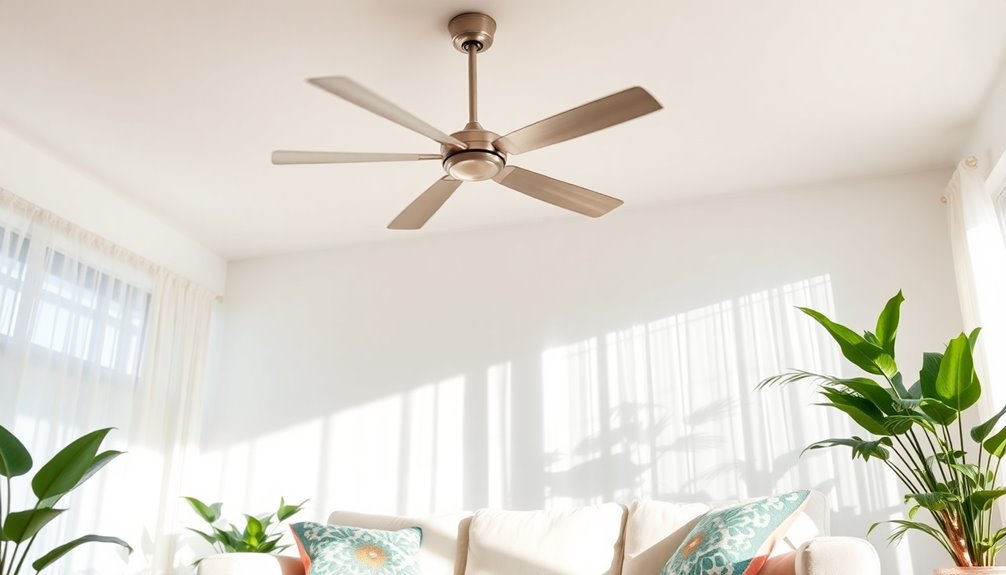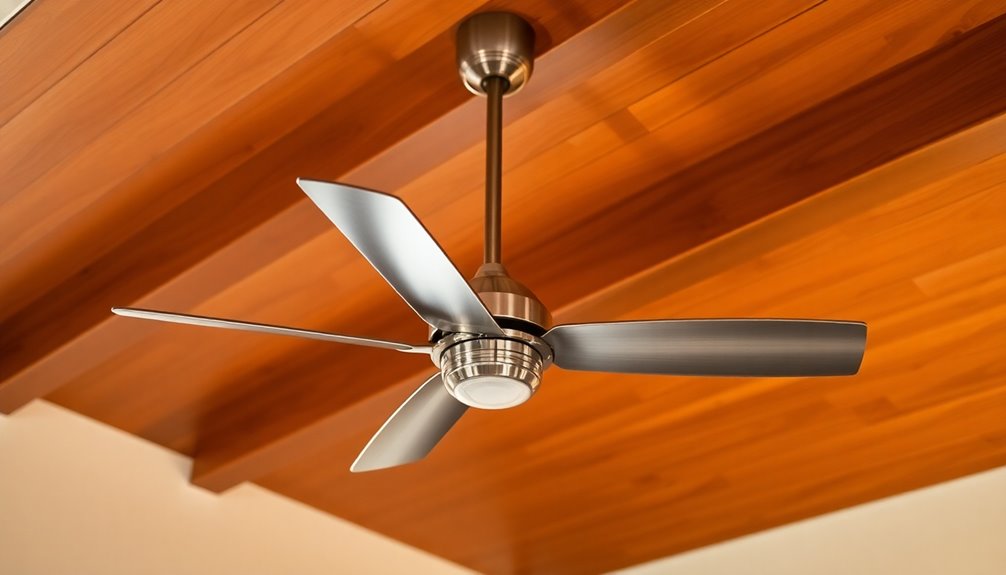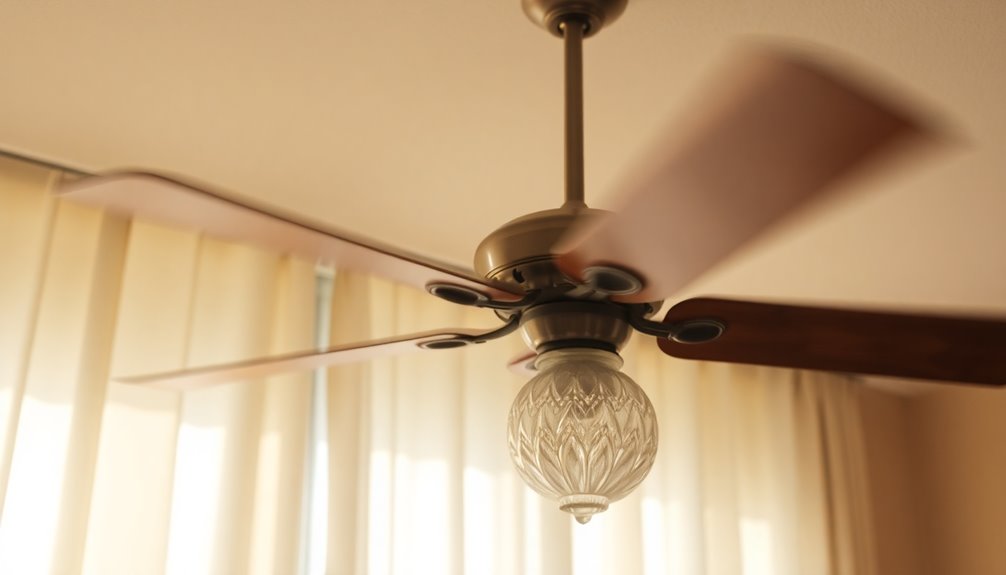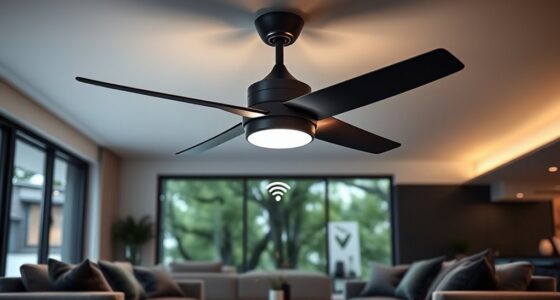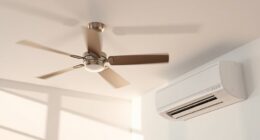To choose the right ceiling fan size for your bedroom, start by measuring your room. For standard bedrooms up to 144 sq ft, a fan with a blade span of 44 to 50 inches works best. Smaller rooms around 75 sq ft need fans sized 29 to 36 inches, while rooms between 76 to 144 sq ft should opt for 36 to 42 inches. If your bedroom is larger, over 225 sq ft, use a fan with a diameter of 52 inches or more. Understanding these specifics helps optimize comfort and airflow, and there's much more to take into account for the perfect fit.
Key Takeaways
- Measure the room's length and width to determine total square footage, guiding the fan size selection.
- For bedrooms up to 75 sq ft, choose fans with a blade span of 29 to 36 inches.
- Bedrooms between 76 to 144 sq ft require fans sized 36 to 42 inches for optimal airflow.
- Larger bedrooms (145 to 225 sq ft) typically need fans with a blade span of 44 to 50 inches.
- Extra-large bedrooms over 225 sq ft should have fans with a diameter of 52 inches or more for effective cooling.
Importance of Ceiling Fan Size

When it comes to creating a comfortable bedroom environment, the size of your ceiling fan plays an important role. Selecting the right size ceiling fan guarantees ideal air circulation, which considerably impacts your comfort levels.
For a standard bedroom size of around 144 square feet, a fan with a blade span of 44 to 50 inches is typically recommended. This size helps maintain excellent airflow without creating uncomfortable drafts.
Using a fan that's too small can lead to inadequate cooling, while an oversized fan may disrupt the room's aesthetic and create an overpowering breeze.
It's vital to measure a ceiling fan properly, taking into account both the fan size and your room's square footage. Also, consider the ceiling height; if your ceilings are over 9 feet tall, you might need downrods to achieve the ideal height for air circulation.
Measuring Your Bedroom Space

To find the right ceiling fan size for your bedroom, start by measuring your space accurately.
Begin by measuring the length and width of your room in feet. Multiply these dimensions to calculate the total square footage of your bedroom. This measurement is essential for determining the appropriate fan size and blade span.
For bedrooms up to 75 square feet, you'll want a ceiling fan with a blade span of 29 to 36 inches for ideal air circulation.
If your bedroom ranges from 76 to 144 square feet, select a fan with a blade span of 36 to 42 inches.
Larger bedrooms, measuring 145 to 225 square feet, typically require a fan with a blade span of 44 to 50 inches to maintain comfort and efficiency.
Don't forget to take into account your ceiling height and room layout when determining the fan size.
A higher ceiling may necessitate a longer downrod, while unique room shapes could influence airflow direction.
Recommended Sizes by Room Type

When choosing a ceiling fan, the size really matters based on your room type.
For instance, smaller bedrooms need compact fans, while larger spaces require bigger models for effective airflow.
You should also consider how you'll use the room, as that can influence your fan choice.
Ideal Fan Sizes
Choosing the right ceiling fan size for your bedroom is essential for achieving perfect airflow and comfort. The ceiling fan size you choose directly impacts how well it can move air and maintain adequate airflow throughout the space.
For bedrooms up to 75 sq ft, a fan size of 29-36 inches is recommended. If your bedroom measures between 76 to 144 sq ft, opt for a fan sized between 36-42 inches to guarantee optimal cooling.
For larger bedrooms, specifically those measuring 145-225 sq ft, fans with a blade span of 44-50 inches are ideal. This size effectively circulates air for a more comfortable environment.
If you have an extra-large bedroom over 225 sq ft, go for fans with a diameter of 52 inches or more to achieve sufficient airflow.
In a standard 12×12 room (144 sq ft), the ideal fan size falls within the 44-50 inch range.
Room Function Considerations
Room function plays a pivotal role in determining the perfect ceiling fan size, as different activities can require varying airflow levels. For instance, you want to guarantee you have ideal airflow and comfort in your bedroom, depending on its size. Here's a quick guide to help you choose the right ceiling fan:
| Room Size (sq ft) | Recommended Blade Span (inches) |
|---|---|
| Up to 75 | 29 to 36 |
| 75 to 144 | 36 to 42 |
| 144 to 225 | 44 to 50 |
In medium-sized bedrooms, a fan with a blade span of 36 to 42 inches is perfect for effective air circulation. For larger bedrooms, the 44 to 50 inch range enhances airflow without overwhelming the space. Additionally, consider your ceiling height; a higher ceiling may require a longer downrod to maintain comfort. Ultimately, selecting the right ceiling fan not only improves air circulation but also complements your room function and style, making your space more enjoyable.
Factors Affecting Fan Size Selection

Selecting the right ceiling fan size involves considering several key factors that influence performance and comfort.
First, the size of your bedroom plays a vital role; for small bedrooms (up to 75 sq ft), fans between 29-36 inches are ideal, while standard bedrooms (75-175 sq ft) require fans sized 42-48 inches.
Ceiling height is another important consideration. If your ceiling is under 8 feet, opt for low-profile fans to guarantee safety and maximum airflow.
Additionally, the blade pitch notably affects air circulation; fans with a higher pitch can move more air, which is especially beneficial in larger rooms.
Fan placement is essential for maximizing airflow and guaranteeing even distribution of cool air throughout the space.
Be mindful of your room's layout, as furniture placement can impact how effectively the fan circulates air.
Finally, think about additional features like remote controls and light kits; these can influence the overall dimensions of the fan and may require careful measurement to maintain effective airflow and comfort in your bedroom.
Fan Height and Clearance Guidelines

When installing a ceiling fan, it's essential to take into account the minimum clearance requirements to guarantee safety and airflow.
Aim for your fan blades to be at least 8 feet above the floor, and if your ceiling is lower, opt for a flush mount to maintain adequate space.
If you have higher ceilings, choose a downrod that keeps the fan at that ideal height for the best performance.
Minimum Clearance Requirements
Guaranteeing proper clearance for your ceiling fan is essential for safety and peak performance. Adhering to the minimum clearance requirements helps prevent accidents and promotes effective air circulation.
Here are some key guidelines to follow:
- Minimum Height: Install your ceiling fan at least 7 feet above the floor to avoid head injuries and guarantee comfort.
- Fan Blade Height: Aim for the fan blades to be approximately 8 feet from the floor. This height allows for effective airflow without creating a windy environment.
- Wall Clearance: Maintain a minimum clearance of 12 inches between the wall and the fan blades to prevent airflow obstruction and guarantee peak performance.
- Flush Mount Fans: If your ceiling is under 8 feet, consider using flush mount fans. These designs keep the fan close to the ceiling, maximizing airflow while maintaining adequate clearance.
Downrod Length Considerations
Choosing the right downrod length is vital for achieving ideal fan height and effective airflow in your bedroom. If your ceiling height exceeds 9 feet, you'll need a downrod to guarantee the fan blades hang at least 8 feet above the floor for maximum airflow and safety.
Standard fan housings are typically 8 to 12 inches tall, so factor this into your total downrod length calculation. For example, a 10-foot ceiling requires a 12-inch downrod, allowing the fan blades to be positioned comfortably at that 8-foot mark.
Additionally, maintaining a minimum clearance of 12 inches between the fan and walls is essential for promoting effective air circulation.
If your room has a sloped ceiling, you'll want to use slope mount fans designed for angles between 34 to 56 degrees. Be sure your downrod length accommodates the specific height of your ceiling in these cases.
Taking all these aspects into account guarantees you'll enjoy both comfort and style while maximizing airflow in your bedroom. Adjusting the downrod length properly can make all the difference in your ceiling fan's performance.
Blade Span and Airflow Efficiency

Selecting the right ceiling fan for your bedroom involves understanding the importance of blade span and airflow efficiency. The ideal blade span typically ranges from 42 to 48 inches, which is sufficient for spaces up to 175 square feet. A fan's pitch—the angle of the fan blades—also greatly impacts airflow efficiency. For the best air circulation, look for a blade pitch of 12 to 15 degrees.
To guarantee you choose the best fan for your comfort, consider the following:
- Blade Span: Confirm it's between 42-48 inches for adequate coverage.
- CFM Rating: Aim for a minimum of 2,000 cubic feet per minute for medium-sized bedrooms.
- Pitch: Opt for a pitch between 12-15 degrees for efficient airflow.
- Speed Settings: Choose a fan with multiple speeds to adjust airflow according to your comfort level.
Longer fan blades can move more air at lower speeds, enhancing efficiency without excessive noise.
Ceiling Fan Motor Types

When choosing a ceiling fan for your bedroom, you'll want to think about the type of motor it uses.
AC motors are popular for their cost-effectiveness and straightforward installation, while DC motors offer enhanced efficiency and quieter operation.
Understanding these differences can help you make an informed decision that suits your needs and saves you money in the long run.
AC Motor Advantages
AC motors stand out as the most popular choice for ceiling fans, delivering reliable performance and affordability for homeowners. When choosing the right size fan for your space, especially in rooms with low ceilings, consider the following advantages of AC motors:
- Speed Settings: Most AC motors offer three speed settings, allowing you to adjust airflow according to your comfort needs, enhancing the cooling effect.
- Ease of Installation: These motors are typically easier to install, making them a favorite for DIY enthusiasts who want to measure from the tip and get started without professional help. Additionally, they can help in reducing allergens such as dust, pollen, and pet dander, contributing to better indoor air quality.
- Longevity: AC motors often have a longer lifespan compared to other motor types, ensuring you get value for your investment.
- Affordability: Generally, AC motors are more economical, fitting into most budgets while providing decent air circulation, which can complement your air conditioning. Additionally, using a ceiling fan can help improve indoor air quality, making your living environment more comfortable and healthier.
While they may consume more energy than ENERGY STAR-rated DC motors, their consistent speed and effectiveness in various applications make them a solid choice for your ceiling fan needs.
Benefits of DC Motors
Experience the numerous benefits of DC motors in ceiling fans, especially when it comes to energy efficiency and comfort.
These motors consume up to 70% less energy than traditional AC motors, which can lead to significant savings on your electricity bills over time. With a greater range of speed settings—often more than three—you can enjoy precise control over airflow and comfort levels in your bedroom.
DC motors also start up faster than their AC counterparts, providing quicker cooling or heating for immediate comfort adjustments. Imagine settling into bed and instantly feeling the invigorating breeze of your fan without the wait.
Plus, their quiet operation enhances the ambiance of your space, making them a perfect choice for sleep settings.
Many ceiling fans equipped with DC motors come with advanced features like remote control and smart home compatibility, adding convenience to your daily routine. These modern fans often boast energy-efficient performance, running quieter and using less power compared to traditional models. Installing one may involve specific wiring requirements, such as properly handling the red wire connection ceiling fan setup for enhanced functionality like light control. With these innovative features, DC motor ceiling fans seamlessly blend modern technology with practicality, elevating both comfort and style in your home.
You can easily adjust your fan settings from the comfort of your bed or couch, ensuring your room stays just the way you like it.
Moreover, the energy-saving features of these fans contribute to a reduction in your overall energy consumption, making them an environmentally friendly choice as well.
Embrace the modern functionality and efficiency that DC motors bring to your ceiling fan experience.
Motor Efficiency Comparison
Choosing the right motor type for your ceiling fan can greatly impact its efficiency and performance. When comparing AC and DC motors, you'll notice key differences that affect your energy consumption and overall satisfaction.
Here's a quick breakdown:
- Energy Consumption: DC motors consume less energy, leading to reduced electricity bills.
- Quiet Operation: If you prefer a peaceful environment, DC motors operate more quietly than their AC counterparts.
- Speed Range: DC motors offer a greater speed range, allowing you to adjust the ceiling fan blades to your comfort level.
- Long-term Savings: While DC motors may have a higher upfront cost, their efficiency can lead to significant long-term savings.
While AC motors are a solid choice for many standard applications, if you're looking for superior motor efficiency and features like remote controls and multiple speed settings, DC motors are the way to go.
Investing in a ceiling fan with a DC motor can enhance your comfort and provide you with the performance you need, making it a smart choice for any bedroom. Additionally, many modern ceiling fans now incorporate advanced filtration systems, ensuring improved indoor air quality alongside efficient cooling.
Installation Tips for Ceiling Fans

Wondering how to install your ceiling fan correctly? First, you'll want to measure the height of your ceiling. Make sure the fan is hung at least 7 feet above the floor for safety and maximum airflow. If your ceiling is higher than 9 feet, consider using a downrod to achieve the ideal height of approximately 8 feet from the floor to the blades.
Before you mount ceiling fans, verify that your electrical box is suitable for installation. Metal boxes are typically required to provide proper support for the fan. It's important to follow the instruction manual for your specific fan model. This guarantees you adhere to safety guidelines and attain the best performance.
If you're unsure which fan do I need, consider the size of your room and the fan's specifications. Choosing a preassembled ceiling fan can also simplify your setup, saving you time and reducing complexity.
Energy Efficiency Considerations

When it comes to energy efficiency, selecting the right ceiling fan can make a noticeable difference in your home's energy consumption. By choosing an energy-efficient ceiling fan, you can greatly reduce heating and cooling expenses while enhancing comfort.
Here are four key considerations:
- CFM Rating: Look for fans with a higher CFM (cubic feet per minute) rating to guarantee ideal air circulation. This can help you rely less on your HVAC system.
- Energy Star Certification: Opt for Energy Star certified ceiling fans, which can save you up to 60% in energy costs compared to standard models. This not only benefits your wallet but also the environment.
- Thermostat Settings: You can raise your thermostat setting by about 4 degrees in summer without sacrificing comfort when using ceiling fans, leading to further savings on your utility bills.
- Regular Maintenance: Keep your fan in top shape by regularly cleaning the blades and confirming proper operation. This helps maintain energy efficiency and prolongs the fan's lifespan.
Additional Features and Accessories

While energy efficiency is a notable factor in selecting a ceiling fan, additional features and accessories can enhance both functionality and aesthetics in your bedroom.
Consider adding a ceiling fan light or a light kit to your fan, which not only illuminates your space but also adds style, with options for LED or standard bulbs. Remote controls are another fantastic convenience, allowing you to adjust your fan's settings from across the room, which is especially helpful when you're cozy in bed.
When choosing your fan, look for models certified by Energy Star, as they can considerably reduce your electricity costs while providing ideal airflow.
Accessories like pull chains can add a decorative touch and facilitate easy operation. If your bedroom has a sloped ceiling, don't forget about an angled-ceiling adapter to guarantee proper installation and safe operation of the fan.
Frequently Asked Questions
Is a 52 Inch Fan Too Big for a 12X12 Room?
Yes, a 52-inch fan is generally too big for a 12×12 room. It exceeds the recommended size, which can lead to uncomfortable drafts and disrupt the room's aesthetic.
Instead, aim for a fan between 36-50 inches to guarantee effective airflow while maintaining comfort.
Choosing the right size enhances energy efficiency, allowing the fan to operate effectively at lower speeds without overpowering your space.
Comfort and design should go hand in hand!
How Big Should a Bedroom Ceiling Fan Be?
You might think a giant ceiling fan could turn your cozy bedroom into a wind tunnel, but that's not the case!
For a standard bedroom, you'll want a fan with a blade span of 44 to 50 inches for ideal airflow. If your space is smaller or larger, adjust accordingly.
Also, consider your ceiling height and the fan's CFM rating to guarantee you're getting just the right amount of air circulation.
What Size Room for a 52 Inch Ceiling Fan?
A 52-inch ceiling fan is perfect for rooms sized between 225 and 400 square feet.
If your room falls within this range, you'll enjoy effective air circulation to keep things comfortable.
Just make sure to mount the fan at least 8 feet above the floor and 12 inches away from walls for ideal airflow.
Consider your ceiling height, too; downrods might be necessary if your ceilings exceed 9 feet.
Enjoy the cool breeze!
Is a 42-Inch Fan Big Enough for a Bedroom?
A 42-inch fan is generally big enough for a bedroom, especially one around 12×12 feet. It provides effective airflow without overwhelming the space, keeping you comfortable.
You'll want to verify it's at least 7 feet above the floor for ideal clearance. If your room has larger furniture or multiple pieces, this size maintains good airflow without creating drafts.
Just remember to check the fan's CFM rating for adequate cooling.
Conclusion
Choosing the right ceiling fan size for your bedroom can make a world of difference in comfort and style. By measuring your space and considering factors like fan height and motor types, you'll create the perfect oasis for relaxation. Don't overlook energy efficiency and extra features that can elevate your experience to stratospheric heights! So take the plunge, pick the ideal fan, and enjoy those cool breezes that'll make you feel like you're sleeping in a cloud!

